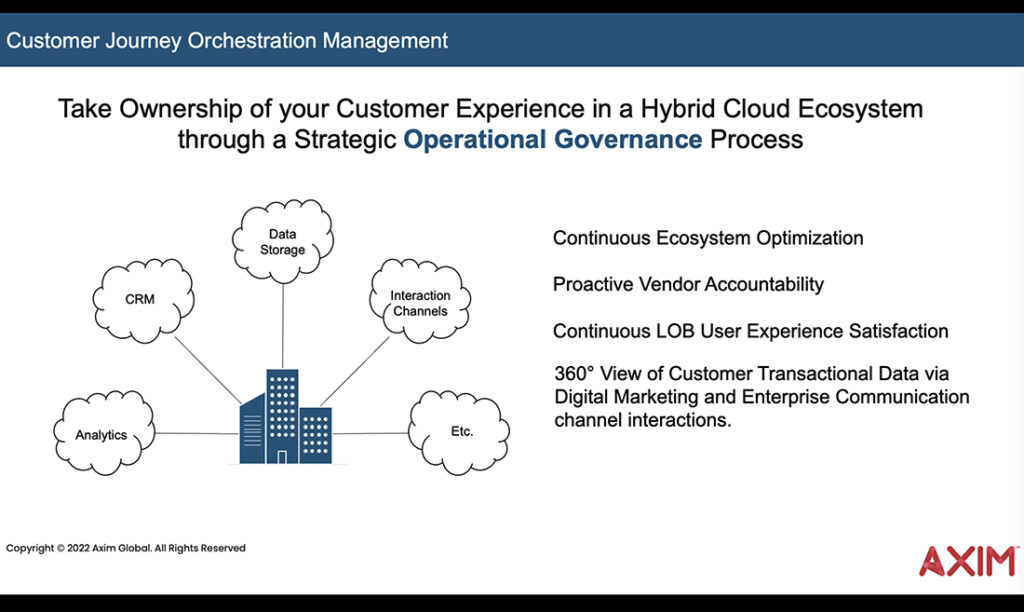When moving your communications platform to a cloud or hybrid environment, it’s essential to be sure your contract reflects your organization’s business outcomes. Simply accepting a vendor’s service level agreement (SLA) can lead to significant issues down the road in terms of managing the customer experience (CX).
“As we move to hybrid cloud environments, it leaders need to retain ownership of the CX ecosystem,” said Scott Sweet, CEO, Axiom Global. “That is the key to maintaining and improving customer satisfaction and meeting your organization’s key performance indicators (KPIs).
Sweet was one of the speakers at a recent IAUG webcast, “Making Managed Services Deliver Meaningful Business Outcomes (not just SLAs),” sponsored by Axim Global. IAUG’s Julie Williams moderated the session, which included insights from Axiom’s Rob Hendricks, director, consulting delivery, and Marcus Gates, SVP, sales and marketing.
“There is a lot of confusion in the market right now about how you invest and evolve your CX,” said Hendricks. “You have to remember that moving from on-prem to the cloud is not a one-to-one migration. Instead, you need to manage a combination of technology stacks, so, an enterprise operational governance plan is mandatory.”

An integrated approach
Integrating digital marketing and enterprise communications is essential for achieving your organization’s business goals in a hybrid CX environment, according to the Axim speakers.
“We tend to focus on enterprise communications but you can’t lose track of the digital marketing channels,” said Gates. “The importance of a seamless integration of customer transactional data cannot be overstated. For example, someone who doesn’t like the contact center experience may post a negative tweet on Twitter.”
By bringing both “silos” together, IT leaders can better orchestrate the customer journey and boost revenue and other KPIs. Think back two decades when IT and telephony were coming together, and the same convergence is happening today, said Gates. “To fulfill the promise of hybrid cloud experience analytics, we need to get a full 360-degree view of how the customer is touching the company,” he added.
Tips for planning
Before moving to a managed service provider in the cloud, here are some other tips from the Axim presenters for planning your migration.
• Map your CX process into the new environment. Again, this should include all the touchpoints with your customers, not just the contact center interactions. Also, think about your agent skill sets and how they might need to change to deliver a consistent customer experience.
• Bring your line of business leaders into the planning process, along with the digital marketing team.
• Do KPI modeling in advance. Get the CFO’s perspective right from the start to be sure you can extract the right data from the new hybrid environment and deliver a positive ROI on the investment.
• Determine what data, applications or hardware will need to remain on prem for management, security or compliance reasons. Then focus on how external providers can help you manage and add value to your CX environment.
• Look for ways to add value from the new architecture, rather than simply replicating your current processes. For instance, how can artificial intelligence (AI) applications be incorporated into the CX analytics process now and in the future.
• Look closely at a vendor’s SLA proposal. For instance, will you have to pay extra for a report extracted from data held by your vendor?
• Build in flexibility for the future. “Your users and your vendors will be asking for more and more in the future,” said Hendricks. “So be sure you take that into consideration as you look ahead to continuous CX ecosystem optimization..”
Summing up the session, Sweet emphasized the importance of understanding your organization’s business needs before reaching out to a managed services vendor. “Your SLAs should be defined by the company’s operational strategy, including data security management, and real-time CX interactions,” he said. “You need to be in charge, rather than the vendor.”
